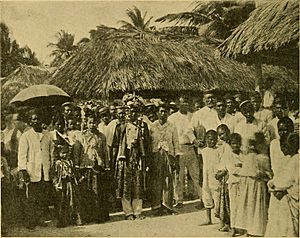Cocos Malays facts for kids

A Malay bride and bridegroom as seen in a wedding event in the Cocos (Keeling) Islands, 1912.
|
|
| Total population | |
|---|---|
| 4,000–5,000 | |
| Regions with significant populations | |
| Languages | |
| Cocos Malay, English, Australian Kriol and Malaysian | |
| Religion | |
| Sunni Islam | |
| Related ethnic groups | |
| Malays, Javanese people, Betawi people, Bantenese |
The Cocos Malays are a group of people who mostly live on the Cocos (Keeling) Islands, which are part of Australia. Today, many Cocos Malays also live on the eastern coast of Sabah, Malaysia. This happened because many families moved there in the 1950s during the time when Britain ruled the islands.
Even though they have become part of the wider Malay culture, they are called "Cocos Malays" because they came from different parts of the Malay Archipelago. Their ancestors came from places like Bali, Celebes, Sumatra, Malacca, and Penang. Some also came from South Africa and New Guinea.
Contents
A Look at Their History
How the Islands Were Settled
The first Malay people arrived on the Cocos Islands around 1826. An English merchant named Alexander Hare brought people from the Malay region to live there. In 1827, John Clunies-Ross and his family also settled on the islands. He brought more Malay people to help grow and harvest coconuts for copra, which is dried coconut meat.
These early settlers were workers, some of whom were forced to come. They came from places like British Malaya, the Dutch East Indies, South Africa, and New Guinea.
Changes in Government
In September 1978, the Australian government bought the Cocos Islands from the Clunies-Ross family. Since then, the islands have been part of Australia. The King of Australia, currently King Charles III, is the head of state. He is represented by an Administrator on the islands.
As of 2019, the descendants of the people brought to the islands by Hare and Clunies Ross are asking the Australian government to recognize them as Indigenous Australians.
Cocos Malays in Malaysia
Many Cocos Malays in Malaysia live in villages called Kampung Cocos. These villages are in the towns of Lahad Datu and Tawau in the state of Sabah. They moved there in the 1950s, brought by the British. About twenty people were in the first group to move, but their numbers grew as more families settled in Lahad Datu.
Their culture is very similar to other Malay people in Malaysia. There are about 4,000 Cocos Malays in Sabah today. This is about eight times more than the number of Cocos Malays still living on the Cocos Islands. The Malaysian government considers them part of the Bumiputera group, which means "sons of the soil."
Their Beliefs and Traditions
Religion
Most Cocos Malays follow the Sunni branch of Islam.
Traditional Clothes
The Cocos Malays have their own special clothes. Women wear the Baju Kebaya and men wear the Baju Melayu. The Baju Kebaya is a loose top worn over a skirt or sarong. The Baju Melayu is a loose shirt, which can have a collar or be collarless.
These traditional clothes are similar to what other Malay people wear. It is believed that their clothing style is a mix of different cultures, including Javanese, Scottish, and English influences.
Their Unique Language
Cocos Malays speak their own language, called Basa Pulu Kokos. Some people think it sounds a bit rough because it uses a lot of slang and words often change their meanings. This language is mostly based on Betawi Malay, which is a mix of Malay and Indonesian. It also has words from English and Scots.
Common Phrases and Words
Here are some words and phrases you might hear in Basa Pulu Kokos:
- Selamat pagi – Good morning
- Selamat ténggah hari – Good Afternoon
- Selamat soré – Evening
- Selamat malam – Good Night
- Apa Kabar? – How are you?
- Kerangkeng – Food closet (a place to store food)
- Ke kaca – Cute
- Kenes – Cute
- Baik – Good
- Jumpa lagi – See you later (or "See you again")
- Korsi – Chair (in Standard Malay, it's Kursi or Kerusi)
- Dostor – Doctor (in Standard Malay, Doktor)
- Esbok – Fridge (from the English word "icebox")
- Bok – Box (in Standard Malay, Kotak)
- Epel – Apple (in Standard Malay, epal)
- Jukong – A special Cocos Malay boat
- Gue/Loh – Me/you (these words come from Betawi Malay)
- Cimni – Chimney (from English)
- Kot – Coat (from English)
- Hiju/Hijo – Green (in Standard Malay, hijau)
- Kalo – if (in Standard Malay, kalau)
- Emak/Mak – Mother (used for women with children)
- Pak/Ayah – Father (Pak is for men with children, Ayah also means father)
- Paman/Man – Uncle (used for men without children)
- Bibik – Aunty (for an aunt who is younger than your parent)
- Nek/Nenek – Grandma (used for grandparents of any gender)
- Wak – A respectful term for a woman with teenage children
- Oh tuhan ku! – Oh my god!
How to Address Elders
Cocos Malays have special ways to show respect when talking to older people:
- If Yusri is a teenager, his mother (Mak Yusri) would be called Wak Yusri.
- When Yusri grows up and has a child named Mustafa, he becomes Man Yusri. Then, Wak Yusri becomes Nek Mustafa (Mustafa's grandma), and Man Yusri becomes Pak Mustafa (Mustafa's father).
- If Mustafa, who is now Man Mustafa and a teenager, has a child named Budi, then Pak Mustafa becomes Nek Budi.
See Also
- Culture of the Cocos (Keeling) Islands
- Malay Australian

